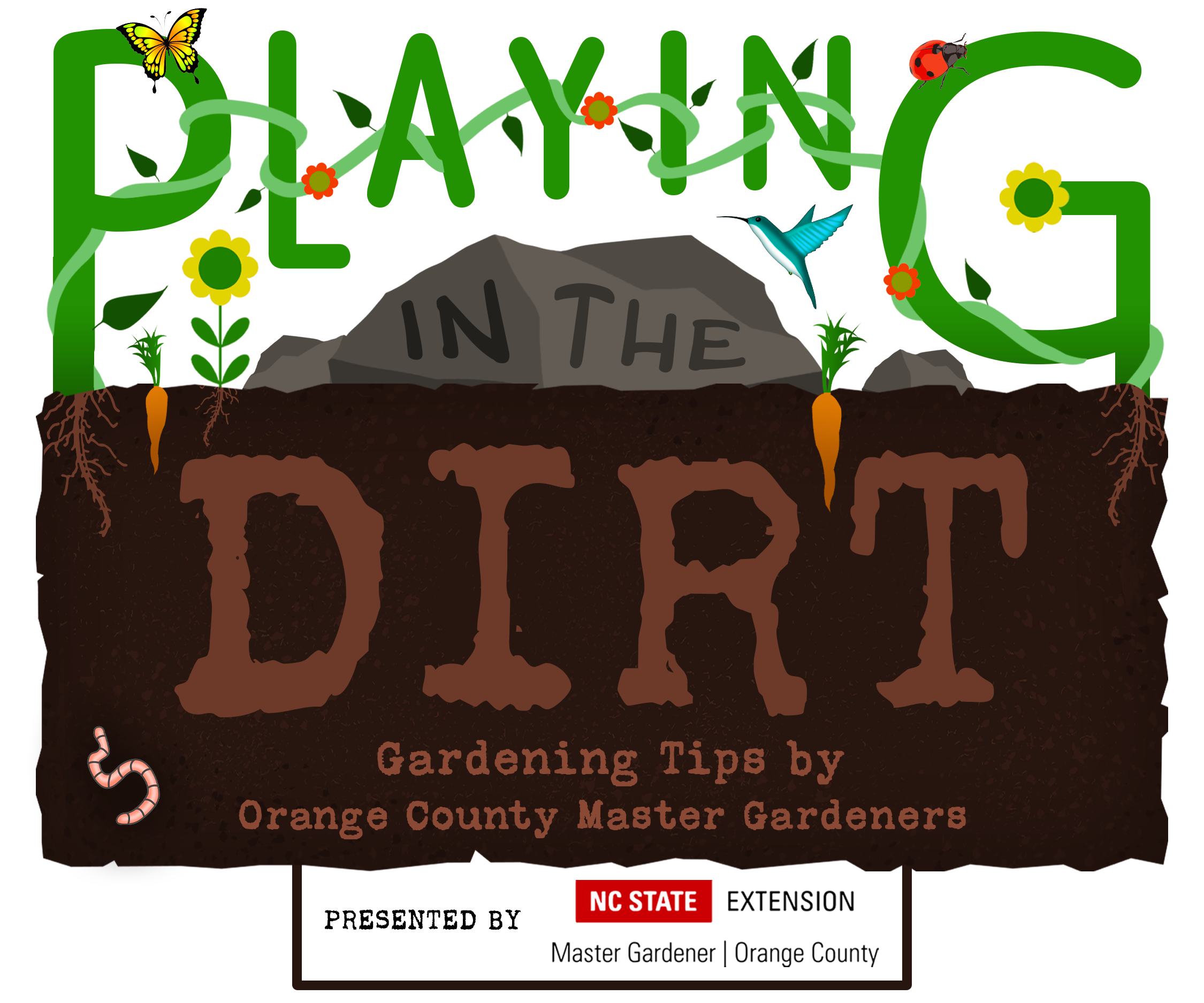
97.9 The Hill and Chapelboro.com have partnered with Orange County Master Gardeners for “Playing in the Dirt,” a monthly column exploring the fertile ground of home gardening in our community and intended to provide the information and inspiration gardeners of all skills levels need to flourish! Check back on Chapelboro each month for a new subject – from our gardens to yours!
By Leigh Simpson , Orange County Master Gardener volunteer
When a local nursery told me that I should spend more money on soil than on plants, it made me think! Plants depend on soil for most of their needs. Soil isn’t just dirt — it is a dynamic ecosystem with many functions. Soil holds oxygen and water, supports the roots of plants, hosts beneficial organisms and provides nutrients that plants need to stay healthy.
Because the physical, chemical and biological processes of soil are interdependent, each needs to function well in order to create a healthy environment for plant life.
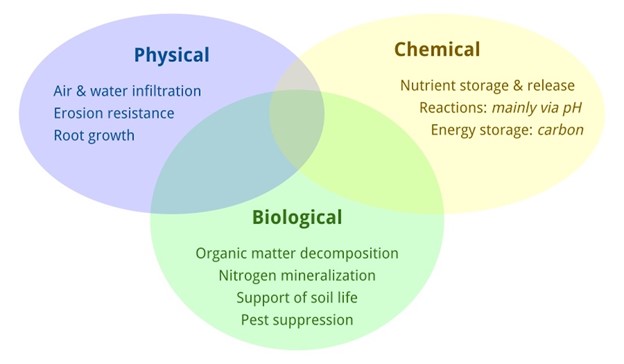
Soil processes. (Diagram by Leigh Simpson)
Creating Healthy Soil
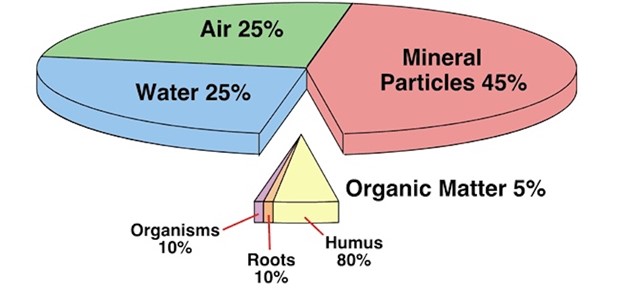
Healthy soils are only 50% solid: they have a sponge-like structure with pores that permit good aeration, drainage, water storage, and root growth.
Most of us have soil that is far from ideal, but we can add materials to improve it and help plants grow well. This is called “amending” the soil. Luckily, amending with organic matter helps.
Organic matter is magical! Organic materials enhance all three parts of soil function:
- Physical: Organic matter improves soil structure, creating better pore spaces for water handling (infiltration, storage, and drainage) and root growth. Organic matter itself has a very high water-holding capacity.
- Biological: Organic matter supplies food and shelter for soil organisms that transform nutrients into a form that plants can use, defend plant roots from pests, aid plant roots in nutrient uptake, and stabilize soil structure.
- Chemical: Organic matter has a high capacity to store nutrients.
Good choices of organic matter for amending soil include compost, leaf mold or manure to improve water storage, and pine fines (pine bark soil conditioner) to improve drainage.
A common recipe for adding organic matter to soil is one part composted manure, three parts garden compost and one part pine fines. Commercial products should be safe but be careful if you use bulk manure or compost because contamination by persistent herbicides used on lawns and pastures can damage or kill your plants. Learn more about herbicide contamination.
How to Amend Soil
Test, Don’t Guess!

Plants acquire 13 essential nutrients from the soil. Nitrogen (N), phosphorus (P), potassium (K), calcium (Ca), magnesium (Mg) and sulfur (S) are needed in the greatest quantities. (Modified from an illustration by Petra Österreich, Pixabay.)
A soil test will show whether the acidity (pH) and levels of some essential nutrients are in the range that your plants need. You can pick up soil sampling boxes, forms and instructions at the new N.C. Cooperative Extension office in Hillsborough (address below) and then drop off your filled boxes for testing. Testing is free from April to November! Just as nice, your test report is tailored to the type of plants that you are growing. Read more about soil testing and how to understand the results.
Let’s Dig!
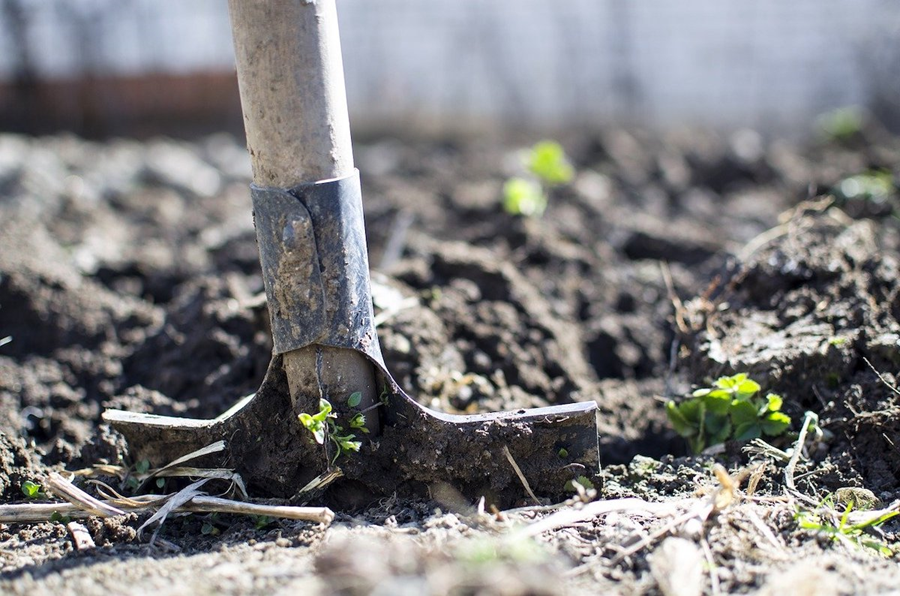
(Photo by Lukas Blazek, Pixabay)
Try to amend the soil at least several weeks before planting to allow the soil to settle and nutrients to better disperse. If the soil needs lime or phosphorus, it is best to amend it at least six months in advance. If you need to amend just before planting, water several times after you have added materials to settle the soil.
To ensure that water will flow between your plantings and the native soil, the garden bed should be dug larger than the root spread of all the plants at maturity. Never amend a single hole! This creates a “bathtub without a drain.” Simply loosen the existing soil to improve aeration.
Check to see if your soil is workable. Clay soil is easiest to work with when slightly moist. If digging is difficult, water the soil and then wait a day or two for it to dry. At the same time, make sure that soil and amendments are not too wet. Test the soil texture by digging down 6 inches, grabbing a handful of soil, and squeezing. If the soil can be crumbled after pressure is released, it can be worked. Otherwise, wait for several days without rainfall and check it again. Then follow these steps:
- Spade or till the soil about 10 to 12 inches deep; that depth is where most plant roots live.
- Add 25% organic matter such as compost. For example, dig to 10 inches, then spread a layer of organic amendments at least 2.5 inches deep on top. Work the organic matter thoroughly into the soil down to almost the depth of the bed. A shallow layer of broken-up, unamended soil at the bottom will aid water movement.
- Mix in a second 25% layer of organic matter, adding any fertilizer or lime as indicated by your soil test report. For long-term plantings, you might substitute a layer of ceramic aggregate such as PermaTill that provides permanent aeration and drainage. Ceramic aggregate needs to be added only once, not each time that you amend.
Learn more about amending, soil drainage and plant selection on the Orange County Master Gardener volunteers’ website, The Orange Gardener.
Protecting Soil
Try the suggestions discussed below to keep your soil’s structure, nutrient content and organisms healthy.
Structure
Certain activities destroy soil structure, leading to compaction, erosion and poor penetration of air, water and nutrients. Avoid:
- Excessive tilling.
- Walking on or working with wet soil.
- Leaving soil bare (protect it with mulch, a ground cover or a cover crop).

Soil compaction prevents air, water, and root movement through the soil.
Nutrient Content
Don’t overwater plants. Overwatering can leach nutrients from the soil.
Soil Life
Avoid chemical fertilizers. They work rapidly but do nothing for soil health. Organic fertilizers — a better choice — work more slowly because they must be broken down by soil organisms first, but they feed soil life, improve soil structure and contribute to long-term soil health.
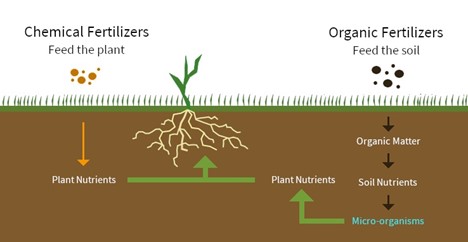
(Illustration by Leigh Simpson.)
Plant a fall cover crop like crimson clover once annuals are removed. A cover crop supports beneficial soil organisms that inhabit the special environment around living plant roots. Also, try growing diverse plant species. Plant diversity increases the diversity and resilience of the soil life below.
Maintaining Soil
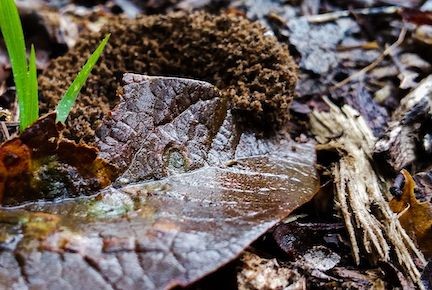
Decomposing leaves and other surface litter. (Photo by Cedrick May, CC BY-SA 4.0, via Wikimedia Commons)
Following nature’s example, let autumn leaves decompose on the ground and return nutrients to the soil. Organic mulches will also compost over time. However, some nutrients are always lost, particularly in annual beds. It is a good idea to test your soil at least every three years and, because organic matter continues to decay, to amend the soil each time that you renovate a bed. It will be easier every time and your plants will thank you!
Additional Resources
- Soil information, including soil test instructions (N.C. Cooperative Extension).
- North Carolina Extension Gardener Handbook, Chapter 1: Soils and Plant Nutrients
- Soil-Test Boxes may be picked up from and returned to the N.C. Cooperative Extension office at The Bonnie B. Davis Environmental and Agriculture Center, 1020 US 70 West, Suite 130, Hillsborough, NC 27278 (across from the DMV driver’s license office).
- Have a plant or garden question for the Orange County Master Gardeners? Email ocmgardeners@gmail.com or phone 919-245-2061. Find plant information at The Orange Gardener and follow us on Facebook (search for OCEMGV).
Chapelboro.com does not charge subscription fees. You can support local journalism and our mission to serve the community. Contribute today – every single dollar matters.

